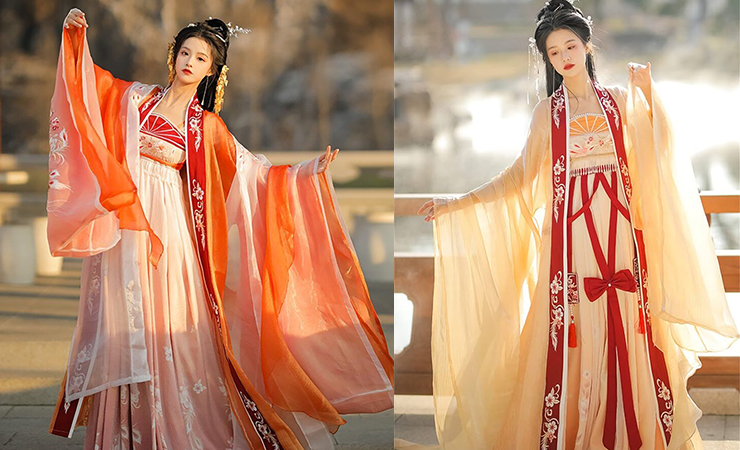
The clothing worn throughout China’s long history varies widely depending on the dynasty, region, and the wearer’s status and gender.
Hanfu
Hanfu is one of the oldest forms of Chinese clothing, dating back over 4,000 years to the Han Dynasty. Characterized by its flowing robes, wide sleeves, and intricate designs, Hanfu was worn by both men and women. For women, the attire often includes a long, floor-length skirt known as a “qun,” paired with a “yi,” a narrow-cuffed, cross-collared shirt. Men typically wore a similar upper garment with trousers or a skirt. The Hanfu’s elegant and refined aesthetics have seen a resurgence in recent years, particularly among young Chinese looking to connect with their cultural roots.
Cheongsam (Qipao)
Originating in the early 20th century, the Cheongsam, or Qipao, is a quintessential Chinese dress for women. This form-fitting garment is known for its high collar, straight skirt, and side slits. The Qipao beautifully accentuates the female form and is often made from luxurious fabrics such as silk, adorned with elaborate embroidery or patterns. Initially a symbol of female liberation in Shanghai, it has evolved into a timeless piece of fashion, worn on formal occasions and by brides during traditional Chinese weddings.
Tang Suit
Tang Suit, despite its name, is not from the Tang Dynasty but is inspired by traditional Chinese jackets. It became popular during the Qing Dynasty and was revived in the late 20th century. Characterized by its mandarin collar, frog buttons, and intricate embroidery, the Tang Suit is often worn during festivals and significant celebrations. It is a symbol of Chinese culture and is typically made from silk or brocade, featuring vibrant colors and motifs such as dragons, phoenixes, and other auspicious symbols.
Zhongshan Suit (Mao Suit)
Named after the revolutionary leader Sun Yat-sen, the Zhongshan Suit, also known as the Mao Suit, became the standard dress for Chinese men in the mid-20th century. This suit features a straight-cut jacket with a standing collar and four symmetrical pockets. It represents simplicity, practicality, and the egalitarian values of the era. While its popularity has waned in everyday fashion, it remains a significant symbol of Chinese history and is still worn on formal state occasions.
Ruqun
Ruqun is another traditional garment for women, consisting of a short jacket known as a “ru” and a long skirt called a “qun.” This attire dates back to the Warring States period and continued to evolve through the Han, Tang, and Song dynasties. The Ruqun is known for its graceful and flowing lines, often adorned with delicate embroidery and patterns.
Shenyi
Shenyi is a traditional men’s robe that dates back to the Han Dynasty. It combines elements of the quju (curved-hem robe) and zhiju (straight-hem robe), featuring a seamless design with a single piece of fabric wrapping around the body. The Shenyi symbolizes the wearer’s social status and is often used in ceremonial contexts.
Diyi
Diyi is an elaborate ceremonial dress worn by noblewomen and empresses during the Zhou and Han Dynasties. This garment is characterized by its wide sleeves, intricate embroidery, and vibrant colors, often featuring motifs such as dragons and phoenixes to denote the wearer’s high status.
Zhiduo
Zhiduo is a long robe with side slits, worn by men during the Ming and Qing Dynasties. It typically features a round collar and a front opening secured with a belt or buttons. Zhiduo was commonly worn by scholars and officials, symbolizing their refined status and intellectual pursuits.
Modern Chinese Clothing
In contemporary China, fashion is a dynamic blend of traditional elements and modern trends. Urban Chinese fashion often includes Western influences, with young people favoring casual and chic styles. However, there is also a growing movement towards embracing traditional Chinese attire like the Hanfu, often blended with modern designs. This fusion of old and new reflects China’s rapid development and its citizens’ desire to preserve their cultural heritage while embracing global influences.
The post Complete Guide to Chinese Clothing appeared first on The Fashiongton Post.
